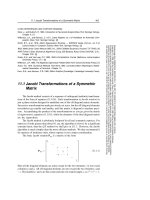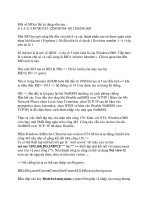HandBooks Professional Java-C-Scrip-SQL part 141 pdf
Bạn đang xem bản rút gọn của tài liệu. Xem và tải ngay bản đầy đủ của tài liệu tại đây (24.13 KB, 6 trang )
|| + + |
|+ + | |
+- + + | | |
| + + +-+ + +
Quantum | | 11510NYBaldwinSteve Heller|
Data | + +
+-
+-
Quantum | 333333333222222222211111111110000000000
Offset | 876543210987654321098765432109876543210
+-
Note that we set the offset value of the deleted item equal to the offset of the item
before it so that its length can be calculated as zero. Now let us add a new street
address of "123 Main Street". After this change, our data structures look like those
in Figure itemref3.
Sample IRA, item index, and data, after field change (Figure itemref3)
+-
| Quantum Item
| Index Number Number
| + +
Item | 0 | 3 1 + +
Reference | 1 | 3 2 + +-+
Array | 2 | 3 3 + +-+ +
(IRA) | 3 | 3 4 + +-+ +-+
| 4 | 3 5 + +-+ +-+-+
| + + | | | | |
+- | | | | |
| | | | |
+- | | | | |
|Item # Offset Type Index | | | | |
| + + | | | | |
| 1 | 12 -+ VARSTRING 0 |± + | | | |
| 2 | 27 +| VARSTRING 1 |± + | | |
Item | 3 | +-34 || VARSTRING 2 |± + | |
Index | 4 | ++-36 || VARSTRING 3 |± + |
for | 5 +-+-++-41 || VARSTRING 4 |± +
Quantum | 6 | | || 38 || UNUSED 0 |
3 | 7 | | || 38 || UNUSED 0 |
| 8 | | || 38 || UNUSED 0 |
| 9 | | || 38 || UNUSED 0 |
| 10 | | || 38 || UNUSED 0 |
| | +-++ ++ +
+- | || |+ +
| || + + |
| |+-+ | |
+- | ++ | | |
| ++ +-+ + + +
Quantum | |11510NYBaldwin123 Main StreetSteve Heller|
Data | + +
+-
+-
Quantum | 443333333333222222222211111111110000000000
Offset | 109876543210987654321098765432109876543210
+-
This is the actual mechanism used to change the value of an item: we delete the old
item and add the new one. Of course, an item that increases in size may no longer
fit in the same quantum, in which case we have to move it to a different quantum.
Keeping track of such changes is not difficult as long as we always use the
standard method of finding the address of an item: look it up in the IRA to get its
quantum number and item number, then use its quantum number and item number
to look it up in the item index. This allows us to move the item to a new quantum
and change only its entries in the IRA and affected item indexes.
For example, if an item was originally in quantum 3 but now no longer fits there,
we might move it to quantum 6. In order to do this, we first delete it from quantum
3 and then add it to quantum 6. As before, all the other IRA entries for items in
quantum 3 still refer to the same data items as before, after we have adjusted the
item index to account for the removed data.
Of course, the deleted item still takes up a slot in the item index of the old
quantum; in our implementation this requires 10 bytes of storage.
9
We need a
method of reclaiming that space, so that we do not gradually fill our quanta with
indexes pointing to nothing. We have already seen part of the solution to this
problem: whenever we are adding an item to a quantum, we search for an unused
item index entry rather than simply adding a new entry at the end.
This mechanism alone would only slow the growth of the item indexes; actually
reducing the size of an index requires us to check for empty entries at the end of
the item index after deleting an item. If such excess entries exist, we reclaim the
space they occupy by reducing the entry count in the item index header to the
number actually in use. This reduces wasted space in the item index without
affecting entries in the IRA. Since we remove unused item index entries only when
they are at the end of the index, no IRA entries can refer to items later in the same
quantum.
A Large Array
Our records are stored in the quanta pointed to by our IRA. The IRA will be stored
in its own quanta, which allows us to make it as large as needed. However, this
means that we can't allocate the IRA in one piece. Since a quantum has a fixed
size, we will have to break up our IRA into segments that will fit in a quantum;
these segments will be collectively referred to as the little pointer array. We'll
also need some way to find the segment that we need for a particular element in the
IRA, which will be the responsibility of the big pointer array.
Figure bigpointer shows the relationship between the big pointer array and the IRA
segments.
From the big pointer array to the IRA (Figure bigpointer)
+ +
| +- |
| Big | element_count = 8000 |
| Pointer | last_quantum_added_to = 3 |
| Array | |
| Header | |
| +- |
| +- |
| | Quantum | Quantum
| | Index Number | 5
| | + + |
| Big | 0 | 2 + + +
| Pointer | 1 | 10 + + +-+
| Array | 2 | 12 + + +-+ +
| | 3 | 14 + + +-+ ++
| | 4 | 11 + + +-+ +++
| | + + | | | |||
| +- | | | |||
| | | | |||
+ + | | |||
+ + | | |||
| |± + | |||
| +- | Quantum | |||
| | Quantum Item | 2 | |||
| | Index Number Number | | |||
| Item | + + | | |||
| Reference | 0 | 3 2 | | | |||
| Array | 1 | 3 4 | | | |||
| (IRA) | 2 | 3 5 | | | |||
| segment | 3 | 3 3 | | | |||
| 0 | 4 | 3 1 | | | |||
| | + + | | |||
| +- | | |||
+ + | |||
+ + | |||
| |± + |||
| +- | Quantum |||
| | Quantum Item | 10 |||
| | Index Number Number | |||
| Item | + + | |||
| Reference | 0 | 3 12 | | |||
| Array | 1 | 4 6 | | |||
| (IRA) | 2 | 4 1 | | |||
| segment | 3 | 4 2 | | |||
| 1 | 4 | 4 3 | | ²²²
| | + + |
| +- |
+ +
Each IRA segment in the real program, of course, holds more than five entries:
with a 16 KB quantum, about 4000 entries will fit in one quantum. However, the
segmentation of the IRA works in the same way as this example. The segment
number can be determined by dividing the element number by the number of
elements in each IRA segment; the index into the IRA segment is the remainder of
that division.
The big pointer array sets a limit on the number of elements referenced by an IRA,
since that array has to fit in one quantum. However, this is not a very restrictive
limit, since one big pointer array can contain about 4000 elements, using a 16 KB
quantum. Each of these elements points to a little pointer array, which contains
pointers to about 4000 entries, as mentioned above. Therefore, we could
theoretically create an array with about 16,000,000 items in it.
Because our ArrayIndex type is defined as an unsigned long, which is
usually 4 bytes, we can actually create arrays of that size.
10
Many Large Arrays
There is one more generalization of the quantum file access method that will make
it more generally useful: the ability to create more than one array of variable-length
items.
The mechanism by which we will accomplish this goal is called the "main object
index", which contains the quantum number of the big pointer array for each
object; the number of an object is set when the object is created, by a directory
facility which we will examine later.
Figure mainindex shows the path from the main object index through the big
pointer array, the IRA segment, and the item index, to finally arrive at the data.
From the main object index to the data (Figure mainindex)
+-
| Index Quantum Number
| + +
Main | 0 |NO_QUANTUM|
Object| 1 | 5 + +
Index | 2 | 9 | |
| 3 | 1 | |
| 4 | 7 | |
+- + + |
+ + |
|Big +- |± +
|Pointer | element_count = 8000 |
|Array | last_quantum_added_to = 3 |
|Header +- |
| +- |









